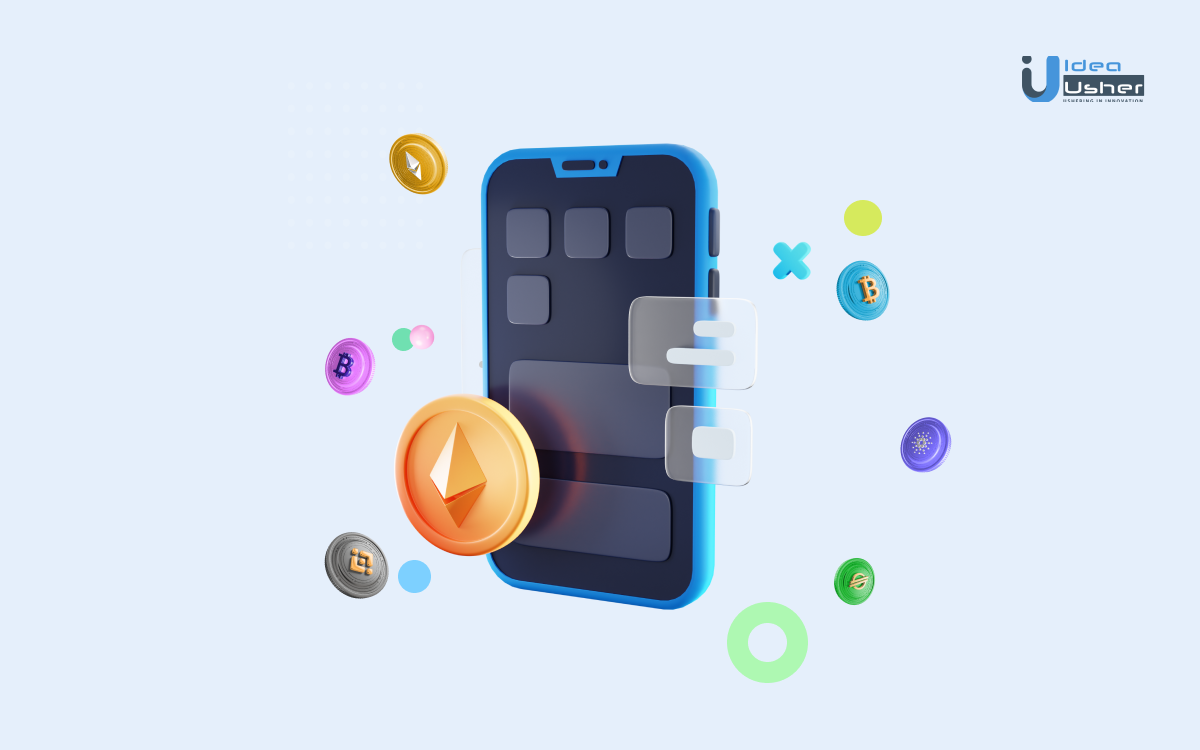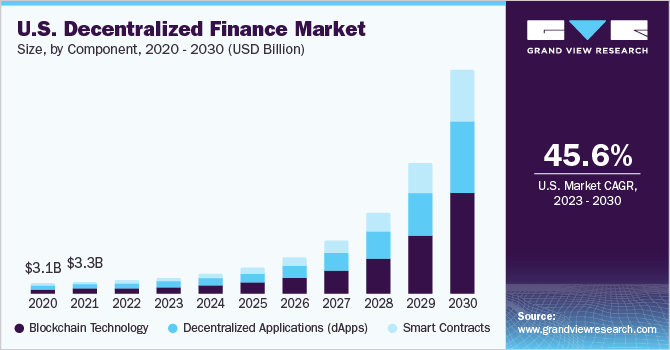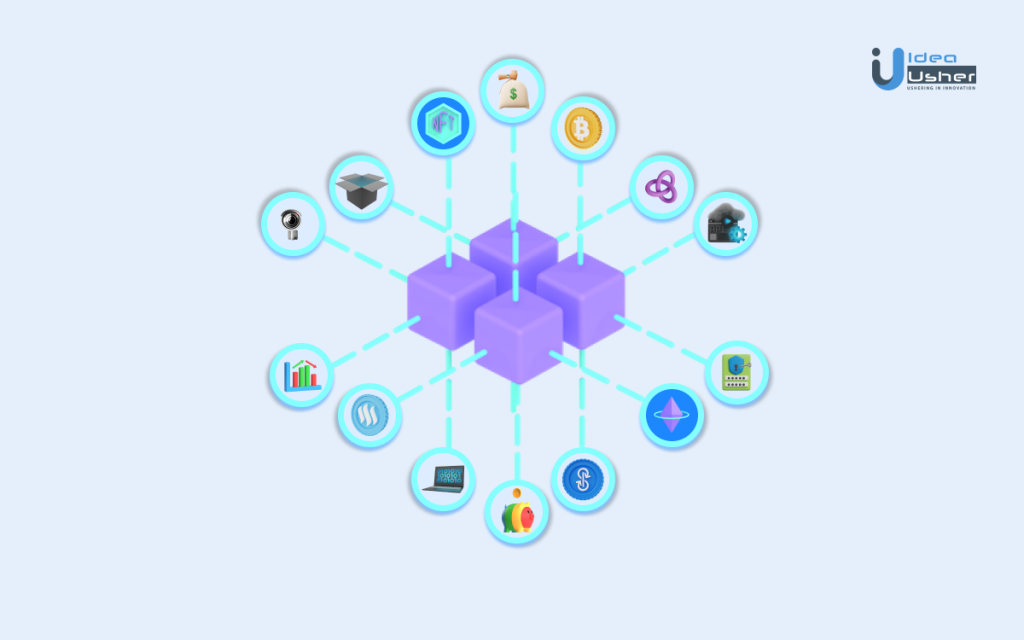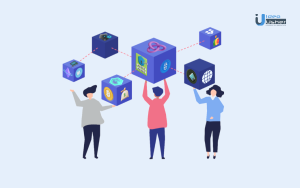- Key Take Aways
- What Are Decentralized Applications? How is it Different From Traditional Apps?
- Why dApps Matter: A Paradigm Shift
- How dApps Are Empowering Users
- Roadmap to Build a Decentralized Blockchain App
- Launching the dApp!
- Marketing the dApp!
- Niches of Decentralized Applications Based on Ethereum
- Methods by Which dApps Reward Network Participants
- Benefits of a Decentralized App for Businesses
- Final Thoughts
- FAQs

A decade later, we may not be able to imagine a world without decentralized mobile apps. Hence, this is the best time for entrepreneurs to invest in these apps. If you want to build a decentralized blockchain app and wonder about things you need to do, you are at the right place. Keep scrolling!
- Key Take Aways
- What Are Decentralized Applications? How is it Different From Traditional Apps?
- Why dApps Matter: A Paradigm Shift
- How dApps Are Empowering Users
- Roadmap to Build a Decentralized Blockchain App
- Launching the dApp!
- Marketing the dApp!
- Niches of Decentralized Applications Based on Ethereum
- Methods by Which dApps Reward Network Participants
- Benefits of a Decentralized App for Businesses
- Final Thoughts
- FAQs
Key Take Aways
- Decentralized applications, or dApps, are applications built on blockchain technology that operate across multiple platforms simultaneously.
- One major challenge with dApps is the initial user onboarding process, as new users need to understand how to use them to fully benefit from their features.
- Prior to beginning the dApp development process, it’s important to choose a suitable blockchain platform.
- There are many factors beyond just transactional capabilities that must be considered when selecting a blockchain platform.
- The global decentralized finance market has experienced significant growth over the past few years, with a market size valued at USD 13.61 billion in 2022. Experts predict that the market will continue to expand at a compound annual growth rate (CAGR) of 46.0% from 2023 to 2030. One of the primary drivers of this growth is the widespread acceptance of DeFi (Decentralized Finance) and its transformative impact on the financial sector.

Source: grandviewresearch
What Are Decentralized Applications? How is it Different From Traditional Apps?
Imagine an app that cuts out the middleman. That’s the core idea behind a decentralized application, or dApp. Unlike the apps you’re used to on your phone, which rely on a single company’s servers, dApps run on a distributed network of computers. Think of it like a global network of shared storage space, constantly verifying and recording information. This network, often powered by blockchain technology.

While traditional apps rely on a single server, decentralized apps harness the power of all the computers on which they work. They work on the blockchain. Each computer is a node, and that makes these apps more reliable.
As there are no single servers in dApps, every node in the network is a mini-server in itself.
Decentralized apps are less prone to failure compared to traditional apps.
The other nodes will keep the decentralized app working if one node is down. But, in traditional apps, this is not possible. As the conventional app relies on a single server, any server failure means the entire app loses its functionality.
Open source: A dApp gives no one the authority to control it. It is an open-source platform where all can view and change the app’s code—using blockchain, which stores data in a cryptographic form.
In a dApp, the front end is like any other traditional app, but blockchain powers the backend. While using a dApp, the user cannot know whether it is a decentralized or ordinary app from the front end.
What would a dApp-based social media look like? The most popular social media platforms use client-server-based traditional models. But, a dApp-based social network will be different from them because anybody will be able to post or comment, and since there is no central authority, no one will be able to delete these comments or posts. Not even the dApp developer will be able to delete/restrict them!
Why dApps Matter: A Paradigm Shift
Decentralized applications (dApps) represent a fundamental shift in how we interact with online systems. Their importance lies in their potential to disrupt existing power structures and empower users:
Decentralized Control: Unlike traditional apps controlled by single entities, dApps distribute control across a network. This fosters a more democratic and censorship-resistant online environment. Imagine a social media platform where users, not corporations, make the rules. This shift in power could lead to more open and accountable online space.
A New Paradigm for Trust: Traditional systems rely on centralized authorities to verify transactions and ensure data integrity. dApps leverage blockchain technology to create a trustless system. The network itself verifies data and transactions, reducing reliance on potentially biased or manipulable third parties. This could lead to more secure and transparent online interactions across various sectors.
Revolutionizing Access: dApps have the potential to democratize access to information and resources. Their decentralized nature eliminates geographical barriers, potentially offering financial tools and services to the underbanked or those restricted by traditional systems. This could promote financial inclusion and broaden participation in the global digital economy.
Shaping the Future of the Web: dApps represent a new wave of applications built on open-source protocols. This fosters innovation and collaboration among developers, potentially leading to unforeseen advancements and functionalities in the future web. This could reshape how we interact with online services and create entirely new categories of applications.
The importance of dApps lies in their potential to fundamentally change how we interact with the online world. They offer a glimpse into a future with more user control, increased transparency, and more equitable access to online resources and services. While challenges remain in development and adoption, dApps hold significant promise for reshaping the digital landscape.
How dApps Are Empowering Users
Decentralized applications (dApps) aren’t just a new app category; they’re a paradigm shift. By removing central control, dApps empower users in exciting ways:
Financial Freedom: Imagine a world where you bypass banks altogether. dApps facilitate peer-to-peer financial transactions, from seamless currency exchange to secure asset transfers. This fosters a more inclusive financial ecosystem, potentially bypassing geographical limitations and hefty fees.
Supply Chain Visibility: Have you ever wondered if your ethically sourced t-shirt actually came from a sustainable farm? dApps can track the movement of goods throughout a supply chain. This empowers consumers to make informed choices by ensuring transparency and accountability within the production process.
Digital Identity Revolution: Imagine a digital ID you control entirely. dApps offer secure storage and verification of personal information, streamlining processes like voter registration or passport applications. This eliminates the need to rely on centralized authorities and empowers individuals to manage their digital identities with greater control.
Healthcare Reimagined: dApps can transform healthcare by putting patients in control of their medical records. Users can securely store and manage their data, granting seamless access to healthcare providers for better collaboration and potentially improved care. This empowers individuals to participate more actively in their own healthcare journey.
Education Without Borders: Imagine a classroom accessible to anyone with an internet connection. dApps can create decentralized learning platforms where students and teachers from across the globe can interact and collaborate directly. This eliminates geographical barriers and fosters a more open and inclusive learning environment.
Beyond these examples, the potential applications of dApps are vast and ever-evolving. From revolutionizing social media ownership to creating predictive markets for collective intelligence, dApps hold the promise of a more user-centric digital future.
Roadmap to Build a Decentralized Blockchain App
Here is your list of the essential steps needed for developing dApps.
1. Know the Project
First, know your project very well to build a decentralized blockchain app.
Why exactly do you want to build a decentralized app instead of a traditional app?
Research to know precisely how much a blockchain project can cost.
The prospects of dApps are up-and-coming. Understand these points about the other dApp projects.
Where did they fail?
Which ideas got traction?
Which projects failed to stay within budget?
The answer to the questions holds the key to your dApp development roadmap.

2. Technologies to Choose for Decentralized App Development
Decide what technology you will use to develop the:
- Contracts programming language: Solidity is the best programming language for Ethereum and Rust for Solana or Polkadot.
- Database: IPFS is a technology of choice with many developers.
- Developer server: Many developers prefer Remix IDE.
- Hostings: A lot of developers use Infura for hosting.
- Framework: Truffle and Hardhat promise technologies for developing frameworks.
3. Initial Coin Offering (ICO)
ICO is the crypto version of traditional IPO (Initial Public Offering) that we see in stock markets. While launching an IPO, companies give away shares. However, there is no need to give up partial control of your company to launch an ICO by releasing shares.
4. Whitepaper
A whitepaper contains the technical aspects of your app and what you expect from your app business. In a whitepaper, visualize the five-year goals you have for your app business.
Emphasize why you think your app business will be a success. A whitepaper should sound professional and convincing to attract investors to fund your decentralized app business.
Making a convincing whitepaper is crucial to building a decentralized app. A compelling whitepaper will appeal to the investors to fund the dApp project.
5. Know the Blockchain Options
Integrate the dApp with an open blockchain or get a custom-made blockchain for your dApp.
How do you want to build your dApp? The options can range from integrating your dApp with an open blockchain like Bitcoin or Ethereum to getting a custom-made blockchain network built.
Use BaaS services: There are many companies like Microsoft and Amazon that provide BaaS products. BaaS stands for blockchain as a service. By using a BaaS model, dApp developers can utilize cloud-based solutions for building and operating their blockchain-based dApps.
Different projects have different requirements, so understand which options suit your project the best.
Do you want to develop a blockchain dApp? Contact our charismatic consultants for blockchain development services.
6. Choose a Platform
While building a decentralized app, the best method is to use Ethereum. It is easy and the most popular way to build decentralized apps. A lot of decentralized apps use the smart contract of Ethereum.
Ethereum comes equipped with all tools that will help to build a decentralized blockchain app. With these tools, decentralized app development becomes even more straightforward and inexpensive.
Using Ethereum means the app developers can use Solidity as a programming language.
Hyperledger: There are also other platforms for dApp development, like Hyperledger. Companies that need a method to exchange data among themselves prefer hyperledger. If you want to use hyperledger, your team should know Go and JavaScript.
R3 Corda: Companies involved in commerce and finance generally employ R3 Corda. R3 Corda is a blockchain platform that builds excellent permissioned blockchains.
Various dApp platforms need teams that use different programming languages. App businesses may have difficulty finding developers who know and have expertise in these programming languages.
Idea Usher has a great team of dedicated developers and blockchain and app development expertise. There will be no shortage of experts who can utilize any platform to make the dApps.
7. Develop the Project
Choose the best programming language that is easy to handle and familiar to your team when developing an app. If you will make your decentralized app on a small scale, start using the smart contracts that Ethereum provides.

Ethereum voting dApps: Consider how the Ethereum voting dApp uses smart contracts. When it comes to reading and writing the blockchain data, then that is what the smart contract does. While using Ethereum, Solidity is the language for writing the decentralized part of the dApp.
Solidity is very similar to JavaScript. Smart contracts represent a contract. When it comes to Ethereum voting dApps, every vote will count equally, and the candidate who gets the maximum votes shall win.
Solidity: If you are using Ethereum, then use Solidity programming language as it is beginner-friendly. While using Ethereum, you will have to pay money in Ether.
For Ethereum developers, Solidity is the language of choice because it is a statically typed language and is used to create smart contracts based on Ethereum.
Scalability: Ethereum users complain of only one major demerit. The limitation is that it is not easy to scale Ethereum dApps. But there are some ways to scale Ethereum dApps as well. So, this is an ideal platform for beginners in dApp development.
However, there are many more excellent programming languages for blockchain app development.
8. Smart Contract Deployment
Specific criteria of smart contracts: Smart contracts mean code that runs on a blockchain network fulfilling particular criteria. When the user gives input into the network, specific parameters determine the output. These are in the form of “if/then” rules.
The transaction is free from interference: Smart contracts allow transactions to be completely free from interference and transparent for all. Smart contracts are ideal for those users who neither want a centralized authority nor lose their anonymity while using the network.
Smart contracts vs. traditional contracts: When you want to buy a property from your friend, a formal agreement is involved. The contract lists the specifications of the property and at which price your friend wants to sell it.
You sign it, pay the fee, and you become the owner. However, a central authority like the government ensures that all parties follow the contract.
But, in blockchain, there is no authority. The agreement contains the terms, and when you make a transaction, the exact amount gets transferred from your bank account to that of your friend. Hence, the process is simplified using blockchain.
These are the steps involved in a smart contract.
- Pre-define the Contract: Upload the conditions to be satisfied in the smart contract.
- Events: If the user fulfills the parameters in the smart contract, then execution is triggered.
- Execution: Based on the parameters, the smart contract determines the outcome.
- Settlement: The contract is settled between the relevant parties.
9. Frontend development
Frontend development is as crucial as the coding part of an app. The user interface should be intuitive and easy to use. The user should not have difficulty locating the frequently used commands and buttons.
Hence, invest in good UI/UX designers. A UI designer makes an intuitive and user-friendly interface, while a UX designer helps to ensure a great user experience to keep the users engaged.
10. Testing
After deploying a smart contract, it can be impossible to change it later in a decentralized app. So, thoroughly check if the app serves its purpose without any loopholes—correct all errors. While you are here, you may like to look at our app development services. Our apps provide a unique user experience with our expertise and the latest technology.
Launching the dApp!
These are the steps a company has to undertake in launching a dApp.
- Get a custom domain for the dApp: Try to get a custom domain name for your app to look professional. After testing, launch the app. Keep the interest around your app alive and kicking even after the launch. Only then can you raise capital from ICO.
- Respond to user feedback: After the app launch, it is time for the owner to see how people respond to the app. After the launch, every app developer expects a lot of downloads. Try to quadruple app downloads.
- Resolve user complaints: If users complain about the app, then as the developer, you have to address and resolve the issue.
- Update and maintain the dApp: Updating and maintaining the dApp is as crucial as developing it. New technologies and operating systems are constantly entering the market, and the app should be compatible with the latest technology.
- dApp business is a long journey: Remember that app development is a lifelong commitment to provide the best services to the users and add value to their lives. Launching the dApp is only the beginning of this long process.
Marketing the dApp!
Building a dApp is the first half of your dApp business. The second half is marketing it. No matter how great your dApp is, it won’t sell itself.
Here are some marketing techniques that you can use.
- Crowdfunding: Keep the interest in your dApp concept alive because this way, you will build an immense fan following who will be ready to fund any project they love. It is called crowdfunding. Marketing an app based on an exciting idea will increase dApp downloads and bring in funds for this project.
- Understand how to make people download your app: Many times, terrible apps get a lot of downloads while the best ones do not. No one knows how great an app is till they have downloaded it.
Without marketing your app, you will not get many downloads in the first place. Since you cannot wear all the hats, contact Idea Usher for the best digital marketing services.
Niches of Decentralized Applications Based on Ethereum
dApps are very revolutionary. Entrepreneurs are crazy about building a decentralized app. Consider these examples, for instance.
1. DeFi (Decentralized Finance Apps)
Financial Institutions will provide you with loans and many other services. But they have centralized servers, and this means that there is a central authority overlooking it. DeFi is a way to provide the same services; however, the only difference is that it is decentralized.
Above all, there are decentralized prediction markets. One example is the Uniswap protocol that the Uniswap company created using Ethereum, and it is a DeFi app.
2. Stable Coin
While cryptocurrencies like Bitcoin are notorious for their fluctuating values, stablecoin tries to keep the weight stable. It limits its value to physical assets like gold or USD. MakerDAO has developed DAI, and it is an example of a stablecoin. Once again, the basis is Ethereum.
3. NFT (Non-Fungible Token)
While cryptocurrency is a fungible token, it is possible to replicate them; there are also non-fungible tokens. They have unique identities and metadata to identify them, and you can never copy them.
They are instrumental in ensuring secure transactions during the trade of unique real-world objects like real estate or art. Again, it can represent your identity, etc.
If you want to develop a dApp based on blockchain technology, then here are 50 blockchain-related terms in everyday use that you must know.
Methods by Which dApps Reward Network Participants
dApps use two methods to reward network participants. These are Proof of Work and Proof of stake.
1. Proof of Work
It is a method of rewarding participants based on their work done for the network. Miners are rewarded for how many transactions they have made in the form of tokens.
2. Proof of Stake
It is a method that allows a participant to vote on a new block based on their stake in the network.
Benefits of a Decentralized App for Businesses
There are many reasons to develop dApps instead of a client-server model-based app.
1. Security
The first reason is the security that the former offers.
- Less chance of data breach: In client-server model-based apps, data breaches can cause massive financial losses. A data breach means unauthorized access to sensitive data.
- No single point of failure: In decentralized apps, the hackers will find no single point of failure to attack and get access to all the sensitive applications. In a blockchain-based network, every node has a complete record of all transactions in the network, and every node has to authorize every transaction.
Hence, the hacker has to hack most nodes working on that network to do malicious things. It, again is impossible in practice.
- Data stored in the blockchain can never be changed: Moreover, if a hacker wants to change the data in any block, they will have to change the data in all the blocks around it. Only then will their activity go unnoticed.
2. Ease of Transaction
Another reason why dApps are gaining popularity is the ease of transaction. While users use mobile apps to avail of banking services, transaction failures are prevalent.
By using dApps, anyone can set up a digital wallet in no time and transact using cryptocurrency without any charges.
3. Consensus
If there is a need to bring about changes in the dApp, the vote and choice of the majority of users will determine this. As dApp is open source, its code is available to everyone for scrutiny.
4. No Censorship
Any user can use the information on the dApp, transact using it, and deploy the dApp for their needs. No one authority can stop any user from making use of dApp.
5. Privacy
For using dApps, users do not have to make their identities public.
6. Integrating the dApp With a Business
A blockchain-based dApp can bring about great wonders by enhancing profits and improving security. If your target users like to transact in cryptocurrency, integrating a dApp will allow the customers to make fast and easy transactions with improved security.
- dApps are great for supply chain-based businesses: In a supply chain-based business, many individuals and devices have to connect. Keeping track of all such activities can be a real challenge. Integrating a blockchain with a supply chain business can easily track all the transactions. As a blockchain is highly secure, dApps can be great tools to authenticate users’ access.
- Alternative to cloud storage: Above all, companies are relying more on cloud storage. Instead of integrating cloud storage into an app, companies can connect their apps to blockchain and provide easy storage solutions.
Final Thoughts
In conclusion, building a decentralized blockchain app in 2024 is a smart and forward-thinking move for any business looking to stay competitive and secure in an increasingly digital world. By leveraging the power of blockchain technology, businesses can create a transparent and tamper-proof platform that provides a high level of security, privacy, and reliability to its users.
At IdeaUsher, we specialize in developing cutting-edge blockchain solutions that cater to the unique needs of our clients. Our team of experienced developers and engineers use the latest tools and technologies to create decentralized apps that are scalable, secure, and user-friendly.
Whether you are a startup looking to create a new decentralized app or an established business looking to integrate blockchain technology into your existing platform, we have the expertise and resources to make it happen. With IdeaUsher’s blockchain services, you can be confident that you are partnering with a trusted and reliable partner who will work tirelessly to ensure the success of your project.
So, if you want to stay ahead of the curve and create a truly innovative blockchain app that delivers real value to your customers, contact IdeaUsher today and let us help you bring your vision to life!
FAQs
Q. How do I create a dApp?
Developing a dApp involves several steps:
- Conceptualize and Define: Identify the purpose and target audience for your dApp.
- Platform Selection: Choose a suitable blockchain platform (e.g., Ethereum, Solana) based on your app’s needs.
- Smart Contract Development: Code the core functionalities of your dApp using the platform’s smart contract language (e.g., Solidity).
- Front-End Development: Build the user interface that interacts with the smart contract, typically using web development frameworks. (Optional) Back-End Development: If your dApp requires additional server-side logic, create a traditional back-end component.
- Testing and Deployment: Rigorously test your dApp to ensure functionality and security before deploying it on the chosen blockchain network.
- Maintenance and Updates: Maintain your dApp and update the front-end or smart contracts as needed.
Q. How do dApps make money?
Several models exist for dApps to generate revenue:
- Transaction fees: dApps can charge users a small fee for interacting with their smart contracts, similar to gas fees on Ethereum.
- In-app tokens: Develop a native token for your dApp that users can purchase and utilize for various functionalities within the app’s ecosystem.
- Subscription fees: Offer premium features or functionalities within your dApp through a subscription model.
- Advertising: Integrate targeted advertising within the dApp interface (though this approach might go against the decentralized ethos for some users).
Q. Can an app on my phone be decentralized?
Technically, an app on your phone can’t be fully decentralized. While the back-end logic might reside on a blockchain, the user interface you interact with on your phone is still a traditional app downloaded from a centralized app store (e.g., Apple App Store, Google Play Store). However, some mobile apps can connect to and interact with decentralized protocols or services.
Q. Is it hard to make dApps?
dApps require knowledge of many aspects involved in app building, marketing, and upgrading. To develop dApps, companies need to hire those developers who know how to use the various technologies your project requires. Besides, dApps are a relatively new concept. Hence, it is best to rely on experienced dApp development companies.








